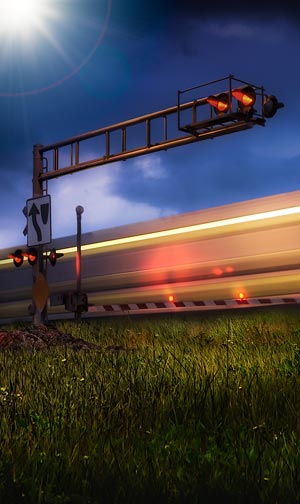Texas Man Killed at Obscured, Unguarded Union Pacific Crossing
(Bryan, Texas – January 3, 2013)
Several days after a 44-year-old Bryan, TX resident was killed by a Union Pacific freight train at the dangerous, unguarded, topographically-obscured crossing of Spur 231 and UPRR tracks, debris of the tragedy still littered the ground around the fatal intersection Thursday in Robertson County, TX.
Reginald Thomas was killed instantly as he attempted to traverse the crossing Friday afternoon, December 28, and according to DPS Trooper Jimmy Morgan, “investigators believe that Thomas did not see the train until he was on the tracks.” Even though trains approach the crossing from a tree-lined, ascending grade, nothing but passive, standard railroad crossbucks and highway yield signs protect motorists from unseen, oncoming trains. There are no flashing lights, bells or crossing gates to keep tragedies such as Friday’s from happening, even though railroad industry sources have long claimed that the existence of such devices could prevent as many as 90% of similar accidents.
Broken glass, metal and even the owner’s manual to the 1993 Ford pickup truck the victim was driving are strewn at the crossing, reminders of a tragedy that residents have long predicted was inevitable.
Spencer Caldwell, who, with his wife, live barely 50 yards from the crossing, has long been wary of the danger both drivers approaching the crossing as well as the couple’s children and grandchildren, playing in their yard, face daily as the trains pass the Caldwell’s residence.
“There are probably trains that come through every 30-45 minutes,” states Caldwell, who has lived in his house near the crossing for about 14 months. “If a train were coming, you probably wouldn’t hear until they’re about 20 yards away, or sometimes when they’re (motorists) crossing the middle of the intersection. Aside from the stop sign and the “private road” sign (even though Spur 231 is a publicly-maintained road), there is nothing standing in the way of those tracks,” he warned a TV news crew from KTBX-TV in Bryan, TX as they discussed TXDOT’s classification of the crossing as “rural”, and with insufficient traffic counts to qualify for upgraded protection.
“A person’s life is just as important as if you live in the big city; if it can save one person, then I think they need to think about putting some crossing arms up,” Caldwell concluded.
Meanwhile, TXDOT promises to evaluate the crossing again after the accident reports are received and analyzed in order to determine if changes need to be made.


